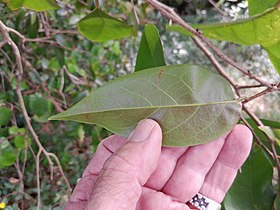Species of flowering plant
Cleistanthus hylandii Bernie's Cleistanthus , is an evergreen plant in the family Phyllanthaceae which is endemic to Cape York Peninsula in far northern Queensland , Australia.
Description
Cleistanthus hylandii is a shrub or small tree up to 8 m (26 ft) high. The leaves are simple and alternate ,[ 5] [ 6] petioles from 2 to 15 mm (0.1 to 0.6 in) long.[ 6] [ 7] glabrous (without hairs) and are ovate to elliptic .[ 6] [ 7] [ 5] [ 7]
The inflorescences are produced either terminally or in the leaf axils , the flowers very small at about 2 mm (0.1 in) diameter.[ 5] [ 6] [ 7] capsule about 7 mm (0.3 in) diameter.[ 5] [ 6] [ 7]
Taxonomy
This species was first described in 1976 by the English botanist Airy Shaw , based on material collected by the Australian botanist Bernard Hyland near the Claudie River in Cape York Peninsula .[ 3] [ 8] New or Noteworthy Australian Euphorbiaceae was published in the Kew Bulletin .[ 5] [ 9]
Etymology
The genus name Cleistanthus is derived from the Ancient Greek words kleistós ánthos petals being enclosed by the sepals in some species.[ 7] species epithet hylandii was chosen by Shaw to honour Hyland.[ 6] [ 7]
Conservation
This species is listed by both IUCN and the Queensland Department of Environment and Science as least concern .[ 2]
Gallery
References
^ IUCN SSC Global Tree Specialist Group & Botanic Gardens Conservation International (BGCI). (2021). "Cleistanthus hylandii " . IUCN Red List of Threatened Species 2021 : e.T192496172A192496174. doi :10.2305/IUCN.UK.2021-1.RLTS.T192496172A192496174.en . Retrieved 8 October 2022 . ^ a b "Species profile—Cleistanthus hylandii " . Queensland Department of Environment and Science . Queensland Government . 2022. Retrieved 8 October 2022 .^ a b "Cleistanthus hylandii " . Australian Plant Name Index (APNI)Australian Government . Retrieved 12 May 2023 .^ "Cleistanthus hylandii Airy Shaw " . Plants of the World Online Royal Botanic Gardens, Kew . Retrieved 8 October 2022 .^ a b c d e F.A.Zich; B.P.M.Hyland ; T.Whiffen; R.A.Kerrigan (2020). "Cleistanthus hylandii " . Australian Tropical Rainforest Plants Edition 8 (RFK8)Australian Government . Retrieved 8 October 2022 . ^ a b c d e f Spokes, T.M.; Forster, P.I. (2022). Kodela, P.G. (ed.). "Cleistanthus hylandii " . Flora of Australia Australian Biological Resources Study , Department of Climate Change, the Environment and Water: Canberra. Retrieved 12 May 2023 . ^ a b c d e f g Cooper, Wendy; Cooper, William T. (June 2004). Fruits of the Australian Tropical Rainforest ISBN 9780958174213 ^ Shaw, H.K. Airy (1976). "New or Noteworthy Australian Euphorbiaceae". Kew Bulletin . 31 (2): 341– 398. doi :10.2307/4109179 . JSTOR 4109179 . ^ "Cleistanthus hylandii " . International Plant Names Index (IPNI)Royal Botanic Gardens, Kew . 2021. Retrieved 8 October 2022 .
External links



